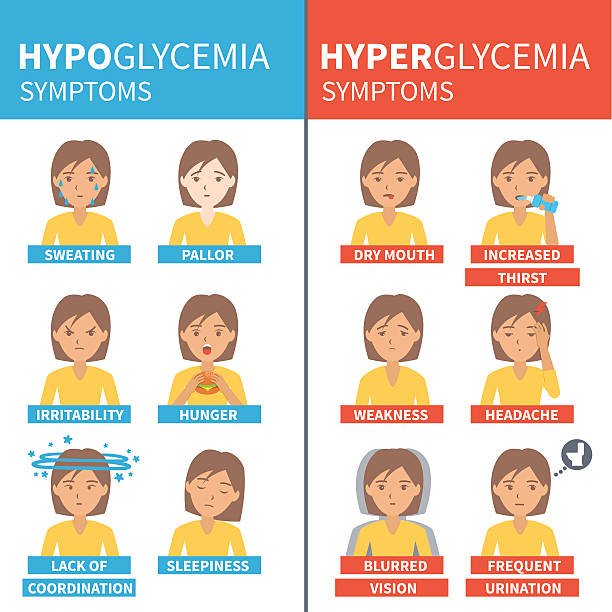
Understanding Blood Sugar: Definitions and Symptoms of Hyperglycemia and Hypoglycemia
For diabetics, testing blood sugar at any time is one of the necessary daily routines. Controlling blood sugar is very important. One of the characteristics of diabetes is hyperglycemia. Therefore, drugs and insulin are used to stabilize blood sugar. However, diabetic patients still need to pay attention to their blood sugar levels at all times to avoid hypoglycemia or ketoacidemia (or ketoacidemia). It is called diabetic ketoacidosis (DKA) and other acute complications.
It is important for people with diabetes and their friends and family to recognize the symptoms of both high and low blood sugar. Not only can you test your own blood sugar, you can also detect signs and avoid more serious problems. This article will introduce the definition and symptoms of hyperglycemia or hypoglycemia, and provide methods to control blood sugar.
Normal blood sugar levels
For most healthy individuals, normal blood sugar levels are as follows:
Fasting blood sugar: 70-100mg/dL or 3.9-5.6 mmol/L
Blood sugar two hours after a meal: 70~140mg/dL or 3.9-7.8 mmol/L

What is hyperglycemia?
Hyperglycemia is a common symptom of diabetes. When the body lacks enough insulin or the body becomes resistant to insulin, the blood sugar in the body will not be effectively used, and the blood sugar concentration will rise. When the blood sugar is higher than a certain level, it will cause harm to the body. cause some damages.
Definition and standards of hyperglycemia
Two criteria for high blood sugar:
- Fasting blood sugar value >100mg/dl or >5.6mmol/L:
If it is between 100-125mg/dl or 5.6-6.9 mmol/L, it means “abnormal fasting blood sugar”, that is, the blood sugar is too high, and it is also the so-called “pre-diabetes”. If you are in the pre-diabetes stage, by changing your diet and life methods, there is still a chance to delay or reverse the onset of diabetes. - Oral Glucose Tolerance Test (OGTT): Blood sugar between 140 and 199 mg/dl or 7.8-11 mmol/L two hours after a meal is “glucose intolerance”.
Usually when these two phenomena occur, diabetes is likely to develop in the future; if fasting blood sugar is too high, the annual risk of developing diabetes will be 3 to 9 times higher than normal, and glucose intolerance or 2 hours after a meal. If blood sugar is high, the chance of developing diabetes every year is 4 to 10 times higher than normal.
Other causes of high blood sugar
However, hyperglycemia may not be caused by factors such as insufficient insulin or insulin resistance. There are also some diseases that can cause hyperglycemia. Such as suffering from hepatitis, cirrhosis and other liver diseases that cause problems with glycogen storage, or suffering from acute infections, colds, strokes, burns or trauma, myocardial infarction, etc., as well as taking diuretics, anti-inflammatory drugs, oral contraceptives, etc. It also affects blood sugar metabolism. In addition, endocrine diseases such as hyperthyroidism, hypercortisolism, and acromegaly may also cause high blood sugar.
Symptoms of high blood sugar
Common symptoms of hyperglycemia are as follows:
- Frequent urination
- Tired and sleepy
- Nausea
- Often hungry or thirsty
- Blurred vision

What is hypoglycemia?
Symptoms of hypoglycemia will occur when the blood sugar concentration is <70mg/dl or 3.9 mmol/L when the blood sugar level drops sharply from a high concentration. Hypoglycemia can be said to be a more urgent and dangerous situation than hyperglycemia. If not treated in time, it may endanger life safety.
Even diabetics with high blood sugar can experience hypoglycemia. The possible reasons are as follows:
- Drink on an empty stomach
- Eating too late, not eating, or eating too little
- Oral hypoglycemic drugs or insulin do not match meal times
- Excessive dosage of oral hypoglycemic drugs or insulin, such as forgetting to take the medicine and taking the medicine again and again
- Excessive exercise and not eating anything
Symptoms of hypoglycemia
Common symptoms of hypoglycemia are as follows:
- Hands shaking
- Palpitations
- Sweating
- Anxiety
- Dizziness
- Extreme hunger
- Weakness and tiredness
- Irritability
According to the level of blood sugar level, it can be divided into 4 stages:
- In the first stage, the blood sugar level is between 65 and 70mg/dl or 3.6 and 3.9 mmol/L, and there are no obvious symptoms.
- In the second stage, the blood sugar level is between 60 and 65 mg/dl or 3.3 and 3.6 mmol/L, and reverse-regulating hormones begin to mobilize responses to combat hypoglycemia.
- In the third stage, the blood sugar level is between 50 and 60 mg/dl or 2.8 and 3.3 mmol/L, and there are autonomic nervous system symptoms such as rapid heartbeat, trembling hands, cold sweats, and anxiety.
- In the fourth stage, the blood sugar value is less than 50mg/dl or 2.8 mmol/L. The lack of sugar in the brain causes fatigue, drowsiness, confusion, slurred speech, cramps and even coma.
What should I do if I have sudden hypoglycemia?
If you deal with it immediately in the third stage and supplement glucose to increase blood sugar, you can avoid the more serious stage four symptoms. If hypoglycemia occurs but you are still conscious, you should quickly add an appropriate amount of glucose-containing and easily absorbed food. For example, 1 cup of juice, 1 can of drink, 1 spoon of honey, etc. If the symptoms do not disappear, you can eat something more.
If you are unconscious and unable to eat, you must immediately go to the doctor for injection of glucose solution. In most cases, consciousness will return quickly.

How to control blood sugar?
It is best to bring your own blood glucose machine, test blood sugar frequently, and maintain regular and quantitative eating habits to reduce the risk of severe hypoglycemia. When blood sugar is high, it can be lowered in time through exercise and medication. Diabetics need to control their blood sugar well to avoid and delay complications. Here are a few ways to control blood sugar:
- Weight loss helps control blood sugar:
Obese people can improve the function of insulin by reducing their weight by 5 to 10%. - Choose starch with fiber:
Choose whole grains such as brown rice, oats, whole grains, etc. These starches are rich in fiber and take longer to digest and absorb, which can delay the rise in blood sugar. - Control sugar intake:
Fruits and sweets are rich in glucose and disaccharides, which can cause blood sugar to rise rapidly. People with normal blood sugar are recommended to consume about 2 fist-sized fruits a day, spread out over 3 meals, no more than 1 bowl each time, while diabetics need to limit the amount of fruit to no more than half a bowl at each meal. - Appropriate mineral supplements:
Foods rich in chromium, zinc, magnesium, and calcium can help insulin regulate blood sugar, such as whole grains, nuts, leafy vegetables, and dairy products. - Exercise regularly:
Exercise increases the ability of muscles to absorb glucose from the blood.
Blood sugar FAQ
What are the symptoms of a sudden rise in blood sugar?
A sudden rise in blood sugar may cause a hyperglycemic emergency. Common symptoms include:
- Hyperosmotic hyperglycemia:
It often occurs in type 2 diabetes. Because insulin cannot maintain blood sugar balance, blood sugar exceeds 600 mg/dl; patients will continue to urinate due to high osmotic pressure, resulting in dehydration and unconsciousness. - Diabetic ketoacidosis:
more commonly occurs in type 1 diabetes, especially when patients discontinue insulin treatment on their own or accidentally contract other diseases. When the body has too little insulin, it begins to break down fat and produce ketone bodies, causing nausea, vomiting, dizziness, coma, and a fruity sweet smell when breathing.
Is hypoglycemia diabetes?
The diagnostic criteria for diabetes are the following 4 items. If one of them is met, diabetes can be diagnosed (the first 3 items need to be repeated and verified more than 2 times):
- Glycated hemoglobin (HbA1c) ≧6.5%
- Fasting plasma glucose ≧126 mg/dL or 7 mmol/L
- Oral glucose tolerance test 2nd hour plasma blood glucose ≧200 mg/dL or 11.1 mmol/L
- Typical symptoms of hyperglycemia (eating, drinking, urinating and weight loss) and random plasma glucose ≧200 mg/dL or 11.1 mmol/L
It can be seen that hypoglycemia cannot be judged as diabetes. Hypoglycemia in non-diabetic patients usually has the following possibilities:
- Taking pneumonia or antibiotic medications
- Alcoholism affects liver function
- Anorexia or severe malnutrition
- Adrenal gland or pituitary gland disease
- Insulinoma
People with diabetes often experience hypoglycemia due to factors such as medications, diet, or excessive activity.










